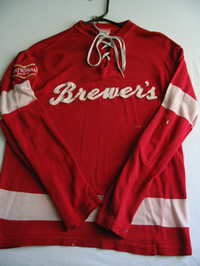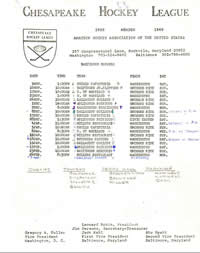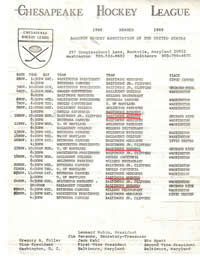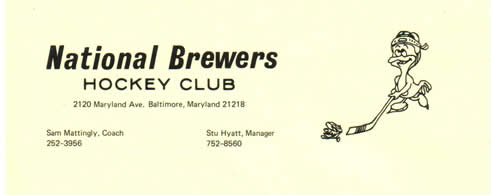1968-1969: The Beginning
In the spring and summer of 1968, Stu Hyatt began the ground work to form a new hockey team in the Metro League of Washington, D.C. Stu had played for many seasons with the Mercurys, a Baltimore based team in the Metro League. Stu Hyatt and one of his former teammates with the Mercury’s, Dick Colonell, approached Roger Goss, the promotions director of the National Brewing Co of Baltimore Maryland, about potential sponsorship. Roger was able to provide a promotional donation from the brewery to sponsor a team to promote their flagship brand, National Bohemian Beer. This new team would be known as the National Brewers. The brewery provided uniforms (red jerseys with ‘Brewers’ in script and red stockings) and a cash donation of $500 to help defray expenses. This donation would help pay for some game and a few practice ice time slots. The team budget was set at $1700 for the initial season with the additional $1200 needed to be player dues. In addition, Roger Goss was interested in playing for the National Brewers and that gave Stu another player to add to the Brewer’s roster. During the summer of 1968, as the new team was being planned, the Metro league had a name change to the Chesapeake Hockey League.
There was a slight problem with building a new hockey team in Baltimore in 1968. With the demise of the Maryland Scholastic Association (MSA) high school hockey league in 1956, very few young players were being prepared to play at the unlimited level. The Baltimore Boys Hockey Program (BBHP), formed in 1962, would now provide most of the younger players. However, the best of these young players were already playing for the Baltimore Jr. Clippers. As a result, the first Brewer’s roster would be mainly composed of players under 18 or over 30 years of age. There was a lack of talented players in the local area, between these two age groups, other than those on the rosters of the Mercurys or Jr. Clippers.
Stu Hyatt approached BBHP president Sam Mattingly, who was also serving as a BBHP team coach. Sam was a former MSA high school player and coach for Calvert Hall in the Sports Centre era. Stu asked for Sam’s recommendations on some of the older BBHP players, including Sam’s 16 year old son Randy Mattingly. After thinking about Stu’s plan and hearing the names of other player possibilities for the Brewers, Sam began to think of a possible playing comeback at age 42. Meanwhile Stu continued to recruit some of his former hockey teammates from the Mercurys and Jr. Clippers.
The initial tryout practice was held on a Saturday morning in October of 1968 at Orchard Ice Rink in Towson, Maryland. This was a strange group of players in the locker room before hitting the ice for the initial practice. There were a few players in their mid 40’s and several who had not shaved yet, due to their young age. In addition, there was one player who was putting on a baseball chest protector and he said that he played center. Looking around the locker room, it looked like a rag tag bunch of skaters, ready to head out to a frozen pond for a neighborhood pick up game.
Sam Mattingly…”I came out to the first practice out of curiosity and because I did have some interest in possibly playing again. After we had been out on the ice individually warming up for about 10 minutes, Stu skated over to me and said, ‘What do you want to do now?’. That was when I realized that I had been appointed coach! I quickly scrambled to create a practice plan, so we could begin using pucks”
It was not tough for Stu and Sam to determine which players would be on the initial National Brewers team. Only a few cuts needed to be made, but the club was polarized by age to even a greater degree than expected. It included six 16 year old BBHP skaters, four from their late teens, three from their 30’s and two from their 40’s, Sam Mattingly and Herb Ryecroft. Earl Gourley was not admitting his age, but it was suspected that he was over 50 years old! Nine of the players were age 18 or under and the club had only two skaters from their 20’s, the prime age to play unlimited full checking hockey.
The 1968-69 Chesapeake Hockey League season began with the National Brewers opening against Sholl’s Cafeteria on November 9, 1968 in the Washington Coliseum. The Brewers took home a 6-2 win and were off to a flying start. For the second game, one day later, things would be a bit tougher. The National Brewers were playing in the West division of the CHL. The league was playing an interlocking division schedule, where the West division teams would play one game against each of the East division teams. Most of the East teams were much stronger than the West teams. On Sunday, November 10, the Brewers faced a strong Jr. Clippers team and lost 8-1 at Orchard Ice Rink. The inexperience of the Brewers young players showed as the season went along and the team began to lose more games. After nine games, the team had won 2 games and had 7 losses. The defense stabilized midway through the season with the addition of Gerry Horak as goaltender. The most noteworthy opponent in the West division was Gallaudet College, the premier college for deaf students in the world. While several were very talented hockey players, most of the Gallaudet team could not hear anything, even the referee’s whistle. Skaters were instructed to stop in place immediately whenever the whistle was blown. However, the Gallaudet players would sometimes continue playing and shoot on goal. In the games at the Washington Coliseum, Gallaudet would sometimes have 2000 fans on one side of the arena, (their campus was 4 blocks away), and the Brewers might have 1 or 2 fans on the visitors’ side. All of these things added up to give Gallaudet a significant home ice advantage.
One of the first year highlights was veteran Earl Gourley recording a ‘birthday hat trick’ in a December 1st win over the Patriots. The January CHL news noted that it had been 43 games since Stu ‘Mr. Clean’ Hyatt had been in the penalty box. In a February game against Miller’s Restaurant, the goalie for Miller’s could not get to the Coliseum and they needed to use a defenseman in the net without goalie pads. A few players were salivating at the thought of shooting against a defenseman. One of team’s players, Ed ‘Tweety’ Sylvester went on a breakaway and actually got called for icing because he shot the puck from behind the center ice line and did not put it on goal. When he returned to the bench, he said “sorry, I panicked”. The Brewers lost that game 4-0. Late in the season, future Brewers’ coach, Bud Hardwick joined the club for several games. In the next to last regular season game, the beer men lost 4-1 to the Mercurys, an East division opponent. There had been significant improvement since the beginning of the season and this loss by a close score illustrated just that.
On February 24, 1969, during the last regular season game in the Coliseum, one of the Brewers’ veterans, Herb Ryecroft, would succumb to a heart attack on the bench after completing a shift. According to Stu Hyatt, Herb’s last shift was the best that Herb had played in a long time. Herb would hear Stu’s compliment just before he collapsed. The game was immediately stopped and not completed. An autopsy later revealed that Herb was due for a heart attack and the stress of playing competitive hockey was not the cause.
The National Brewers finished the first season with a 7-11-0 record that was good for a third place finish, behind Miller’s and Gallaudet, in the West division. The first year club finished in front of Sholl’s Cafeteria, University of Maryland and the Arlington Patriots. Brewer’s scoring was led by Stu Hyatt and Bob Lowry, who was doing a medical residency in Baltimore. Other top contributors on the first year team were: Tom Rochfort, Dick Colonell, Andy Fitzpatrick, Barry Brownlee, Graham Miller, Ron Kosyjana and Walt Quick. After the season, the CHL held playoffs for the top 4 teams in each division. The Brewers were eliminated by Gallaudet on March 3, 1969 by a 6-1 score in the semi final round at the Washington Coliseum, with Brewers’ manager Stu Hyatt picking up the lone tally.



